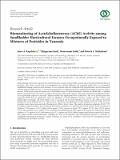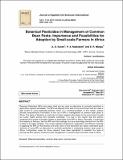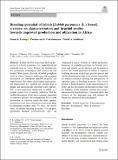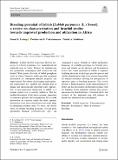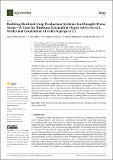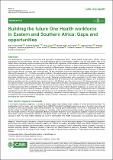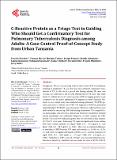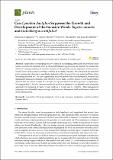Browsing Research Articles [LISBE] by Title
Now showing items 82-101 of 971
-
Biological properties of extracts from locally grown banana leaves indicate their possible use for wound dressing in Arusha, Tanzania
(Embase, 2021-10-01)This study assessed the biological properties and safety profile of extracts from locally grown banana leaves in Arusha (Tanzania), to affirm their possible use for wound dressing. Screening for phytoconstituents in extracts ... -
Biomonitoring of Acetylcholinesterase (AChE) Activity among Smallholder Horticultural Farmers Occupationally Exposed to Mixtures of Pesticides in Tanzania
(Hindawi, 2019-09-11)Biomonitoring of pesticides exposure has currently become a matter of great public concern due to the potential health effects of pesticides. ,is study assessed levels of acetylcholinesterase (AChE) inhibition and associated ... -
Bionomics of the African Apefly (Spalgis lemolea) as A Potential Natural Enemy of the Papaya Mealybug (Paracoccus marginatus) in Tanzania
(MDPI, 2020-04-14)The African apefly (Spalgis lemolea Druce) is a potential natural enemy of the papaya mealybug (Paracoccus marginatus Williams and Granara de Willink). We studied the life history of apeflies in the laboratory at a temperature ... -
Biopesticide efficacy of four plant essential oils against papaya mealybug, Paracoccus marginatus Williams and Granara de Willink (Hemiptera: Pseudococcidae)
(Heliyon, 2023-03-01)Worldwide, P. marginatus causes 75% of estimated economic loss in papaya farming, with an increase in production costs. The extract of plant essential oils (PEO) has the potential to control P. marginatus by degrading ... -
Biopesticides Potential to Protect Tomato (Solanum lycopersicum L.) Production from Early Blight Disease (Alternaria solani) and Leaf Miners (Tuta absoluta)
(preprint, 2025-01-03)Early blight disease (Alternaria solani) and leaf miners (Tuta absoluta) pose significant biotic constraints to tomato production, causing 80 -100% yield loss. A study involving laboratory, screen house and field experiments ... -
Biovar 2 of Ralstonia solanacearum Species Complex Causes Tomato Bacterial Wilt Disease in Tanzania
(Science Alert, 2020-03)Background and Objective: Bacterial wilt disease (BWD) caused by complex species of Ralstonia solanacearum (RSSC) has been categorized as one of the most significant plant diseases in the world. It is a serious problem ... -
Blood cytokine responses to early secreted protein antigen-6/culture filtrate protein-10 tuberculosis antigens 2 months after antituberculosis treatment among patients with drug-susceptible pulmonary tuberculosis.
(Wolters Kluwer - Medknow, 2019-03-12)Background: Human tuberculosis is a chronic inflammatory disease caused by mycobacterium tuberculosis. Pulmonary tuberculosis is the result of the failure of host immune system to control mycobacterium tuberculosis. The ... -
Botanical biopesticides have an influence on tomato quality through pest control and are cost-effective for farmers in developing countries
(PLOS ONE, 2023-11-28)Synthetic insecticides heavily applied to manage agricultural pests are highly hazardous to the environment and non-target organisms. Their overuse through repeated treatments in smallholder farming communities is frequent. ... -
Botanical extracts control the fungal pathogen Colletotrichum boninense in smallholder production of common bean
(Springer link, 2024-04-11)Anthracnose caused by Colletotrichum spp. remains an intractable problem in the most common bean (Phaseolus vulgaris) production areas worldwide and can cause total yield loss. Many smallholder farmers are familiar with ... -
Botanical Pesticides in Management of Common Bean Pests: Importance and Possibilities for Adoption by Small-scale Farmers in Africa
(Journal of Applied Life Sciences International, 2017-06-17)Botanical Pesticides (BPs) have been cited and are used as alternative to synthetic pesticides in agricultural systems worldwide. The BPs are believed to be safe to the environment and are used in pest control to avoid ... -
Breeding potential of lablab [Lablab purpureus (L.) Sweet]: a review on characterization and bruchid studies towards improved production and utilization in Africa
(Springer Netherlands, 2021-09-22)Lablab (Lablab purpureus) [Lablab purpureus (L.) Sweet] is termed a lost, underutilized and neglected crop in Africa. Despite the multipurpose use, production, consumption and research are still limited. Wide genetic ... -
Breeding potential of lablab [Lablab purpureus (L.) Sweet]: a review on characterization and bruchid studies towards improved production and utilization in Africa
(Springer Nature Switzerland AG., 2021-09-21)Lablab (Lablab purpureus) [Lablab purpureus (L.) Sweet] is termed a lost, underutilized and neglected crop in Africa. Despite the multipurpose use, production, consumption and research are still limited. Wide genetic ... -
Brucella Species Circulating in Smallholder Dairy Cattle in Tanzania
(MDPI, 2024-09-21)Brucellosis is a zoonosis caused by bacteria of the genus Brucella, which results in economic losses relating to livestock and threatens public health. A cross-sectional study was conducted to determine the molecular ... -
Brucellosis infection dynamics in cattle and the impacts on production and reproduction in pastoral settings of Tanzania
(Academic Journals, 2022-03)Brucellosis is endemic in pastoral settings of Tanzania with significant socio-economic implications. However, comprehensive studies to establish its impacts had not been elucidated. A longitudinal study was conducted in ... -
Brucellosis testing patterns at health facilities in Arusha region, northern Tanzania
(Plos one, 2022-03-23)Background Brucellosis is listed as one of six priority zoonoses in Tanzania’s One Health strategic plan which highlights gaps in data needed for the surveillance and estimation of human brucellosis burdens. This study ... -
Building Resilient Crop Production Systems for Drought-Prone Areas—A Case for Bambara Groundnut (Vigna subterranea L. Verdc) and Groundnut (Arachis hypogaea L.)
(MDPI, 2023-01-28)Drought is a major crop production constraint worldwide. Some legume crops are known for their ability to resist water deficit stress. This study evaluated the responses of bambara groundnut (Vigna subterranea (L.) Verdc) ... -
Building sustainable societies through vertical soilless farming: A cost-effectiveness analysis on a small-scale non-greenhouse hydroponic system
(Elsevier, 2022-08)The growing rate of population and urbanization among African cities versus the reducing arable land has roused curiosity in soilless farming as an urban farming method to enhance food security and urban sustainability. ... -
Building the future One Health workforce in Eastern and Southern Africa: Gaps and opportunities
(CABI, 2025-04-10)The Quadripartite comprised of the Food and Agriculture Organization (FAO), World Health Organization (WHO), World Organisation for Animal Health (WOAH), the United Nations Environment Program (UNEP), and the One Health ... -
C-Reactive Protein as a Triage Test in Guiding Who Should Get a Confirmatory Test for Pulmonary Tuberculosis Diagnosis among Adults: A Case-Control Proof-of-Concept Study from Urban Tanzania
(Scientific Research Publishing Inc., 2022-03-25)Background: The current screening tools for tuberculosis (TB) are inadequate resulting in insufficient TB case detection and continued community transmission of TB. As the world is geared into finding missing TB cases, new ... -
Can Cynodon dactylon Suppress the Growth and Development of the Invasive Weeds Tagetes minuta and Gutenbergia cordifolia?
(MDPI, 2019-12-06)Approaches to managing invasive plants is challenging, particularly in protected areas where conventional methods, such as chemical herbicide applications are limited. We studied the effects of varying densities of Cynodon ...


